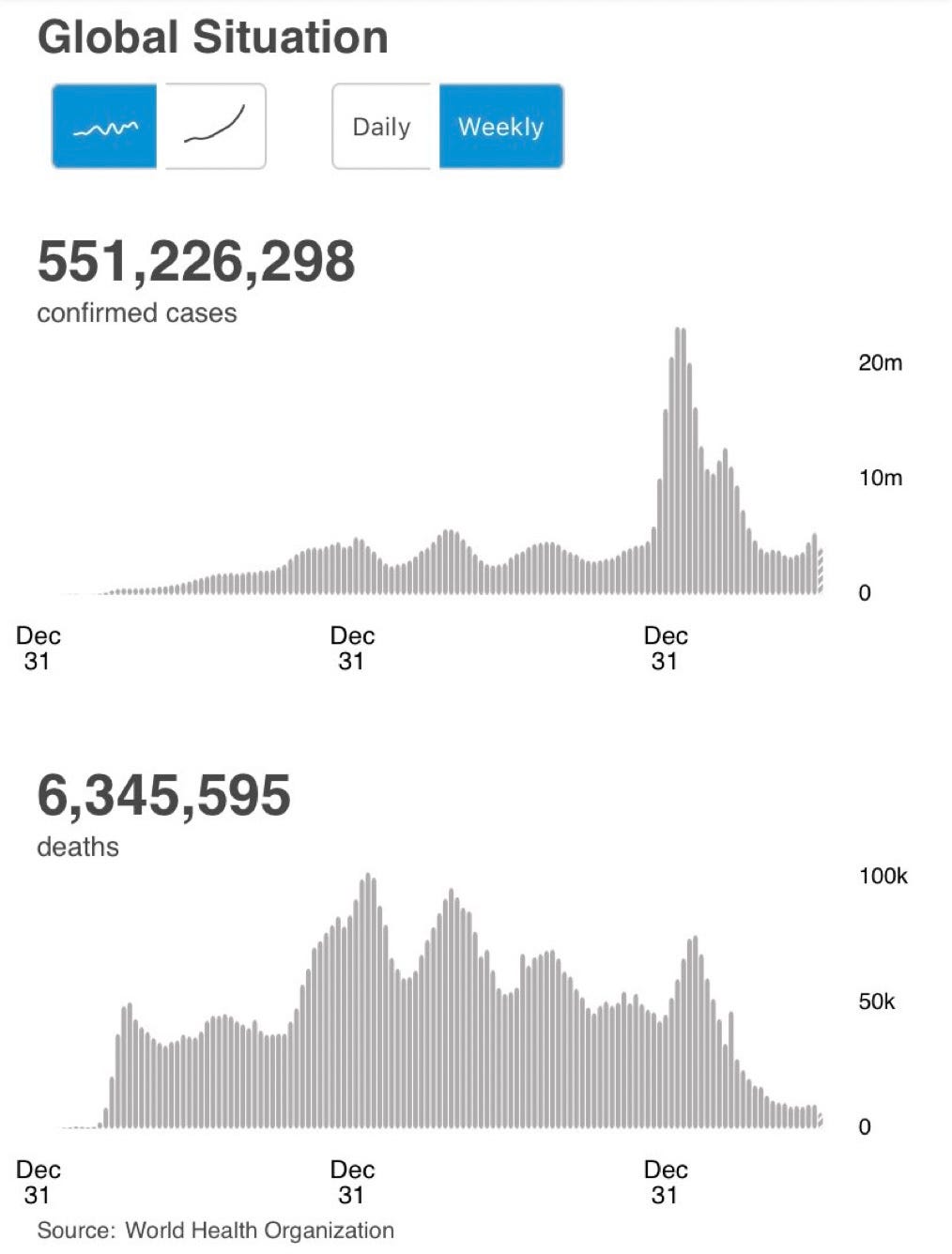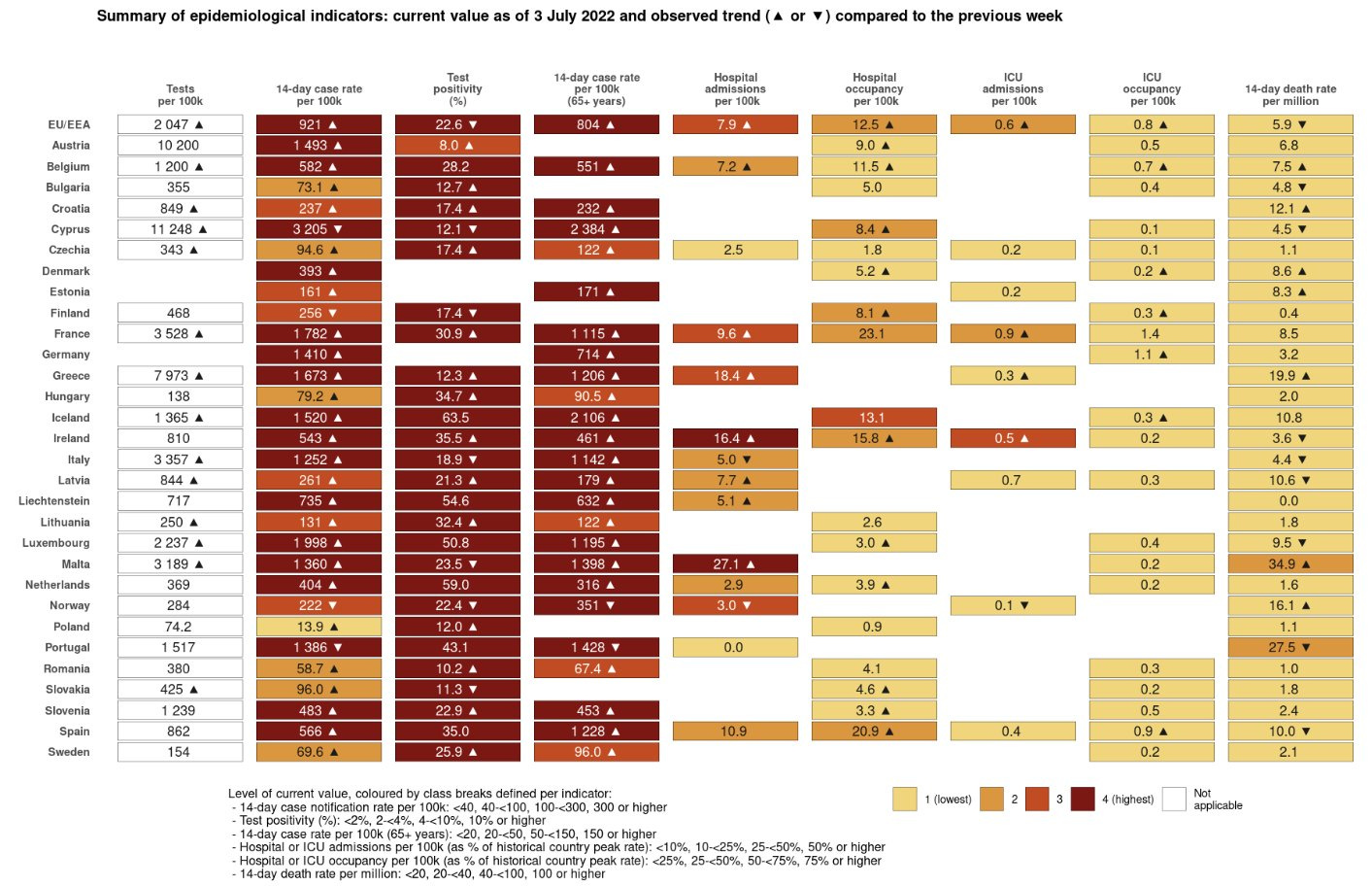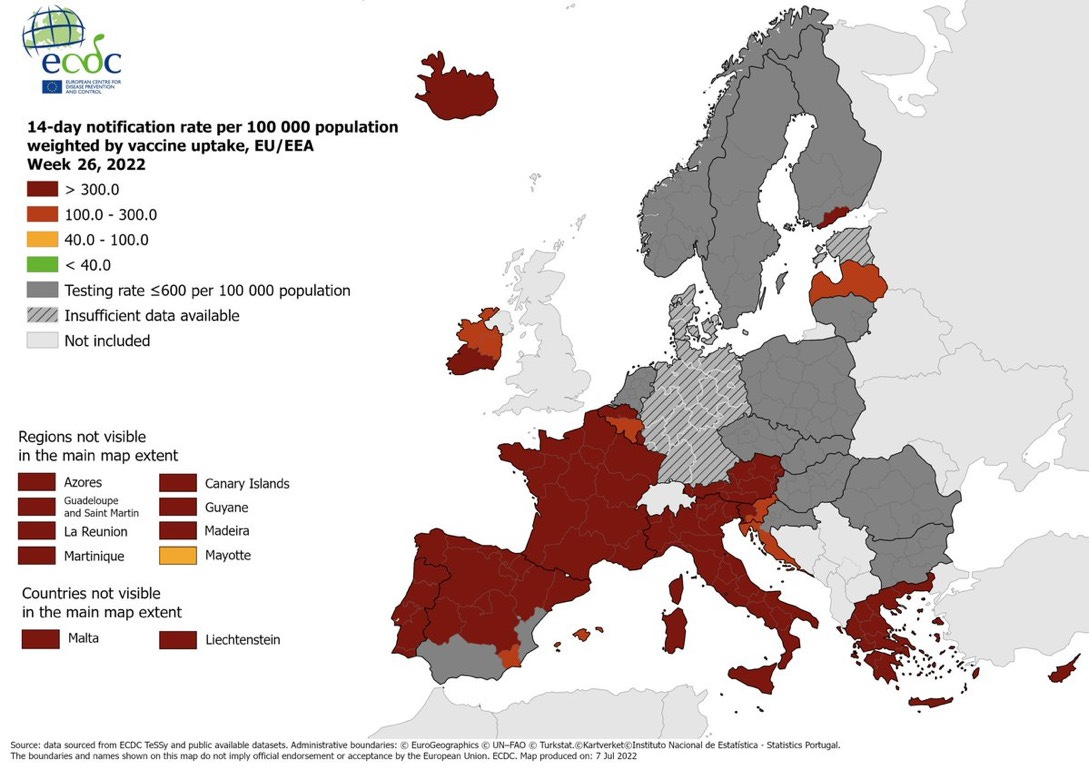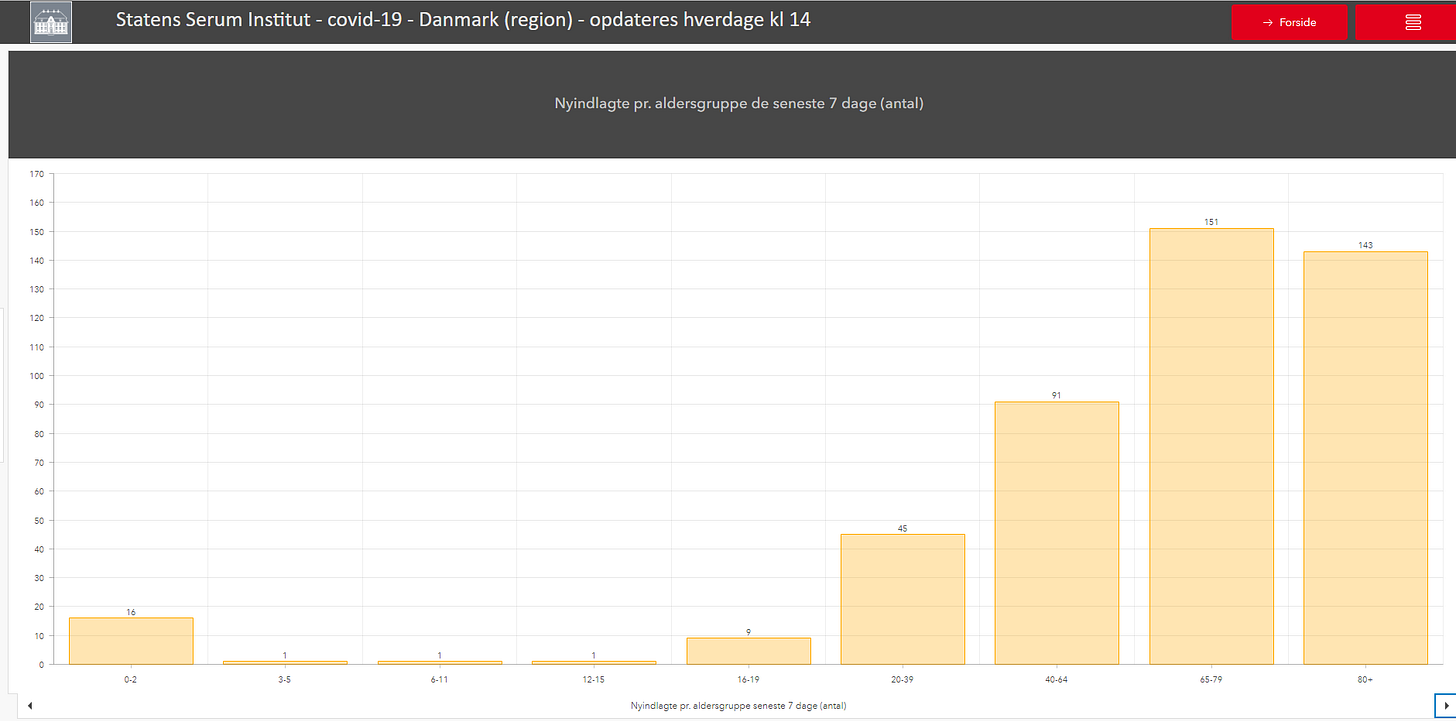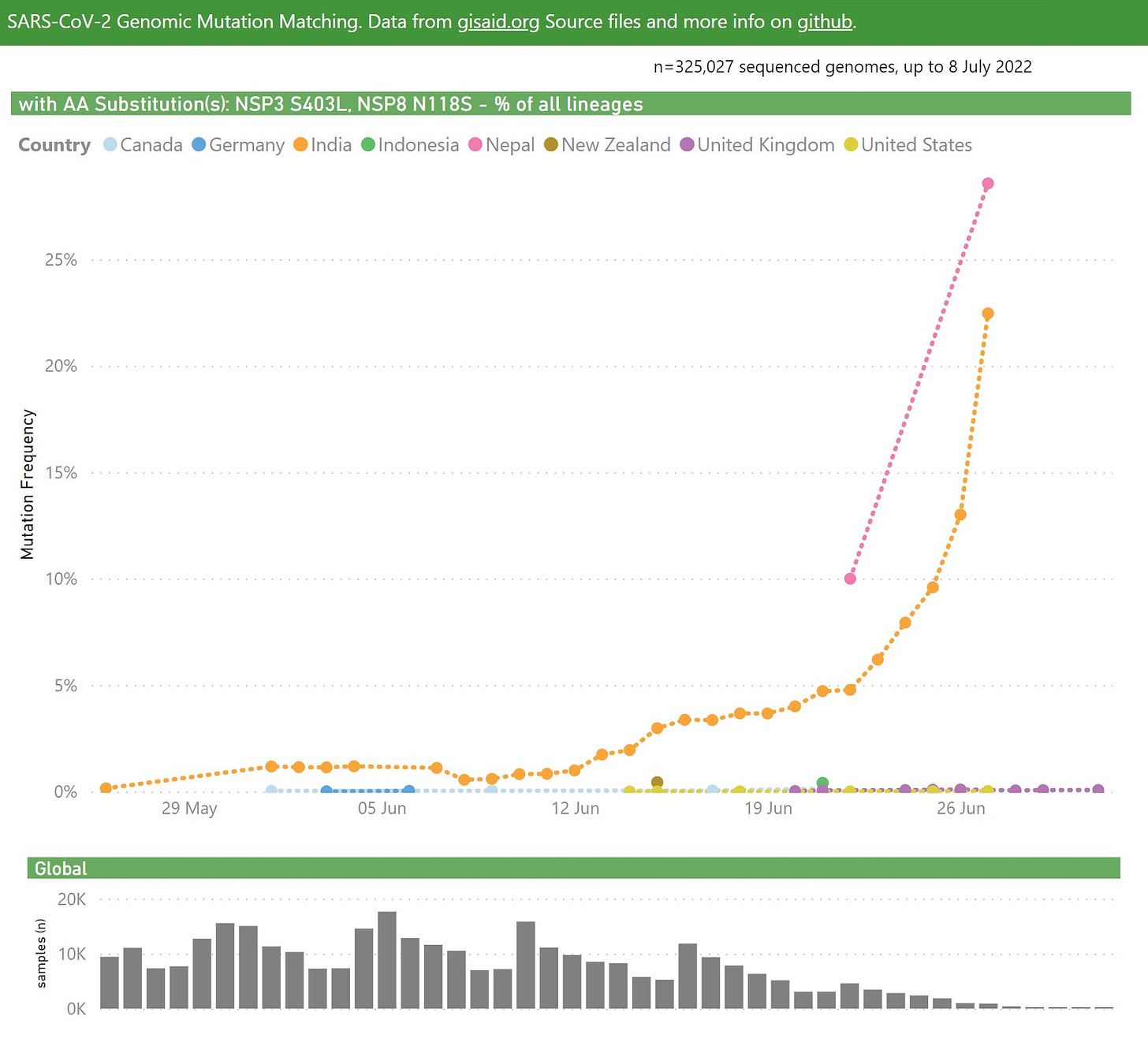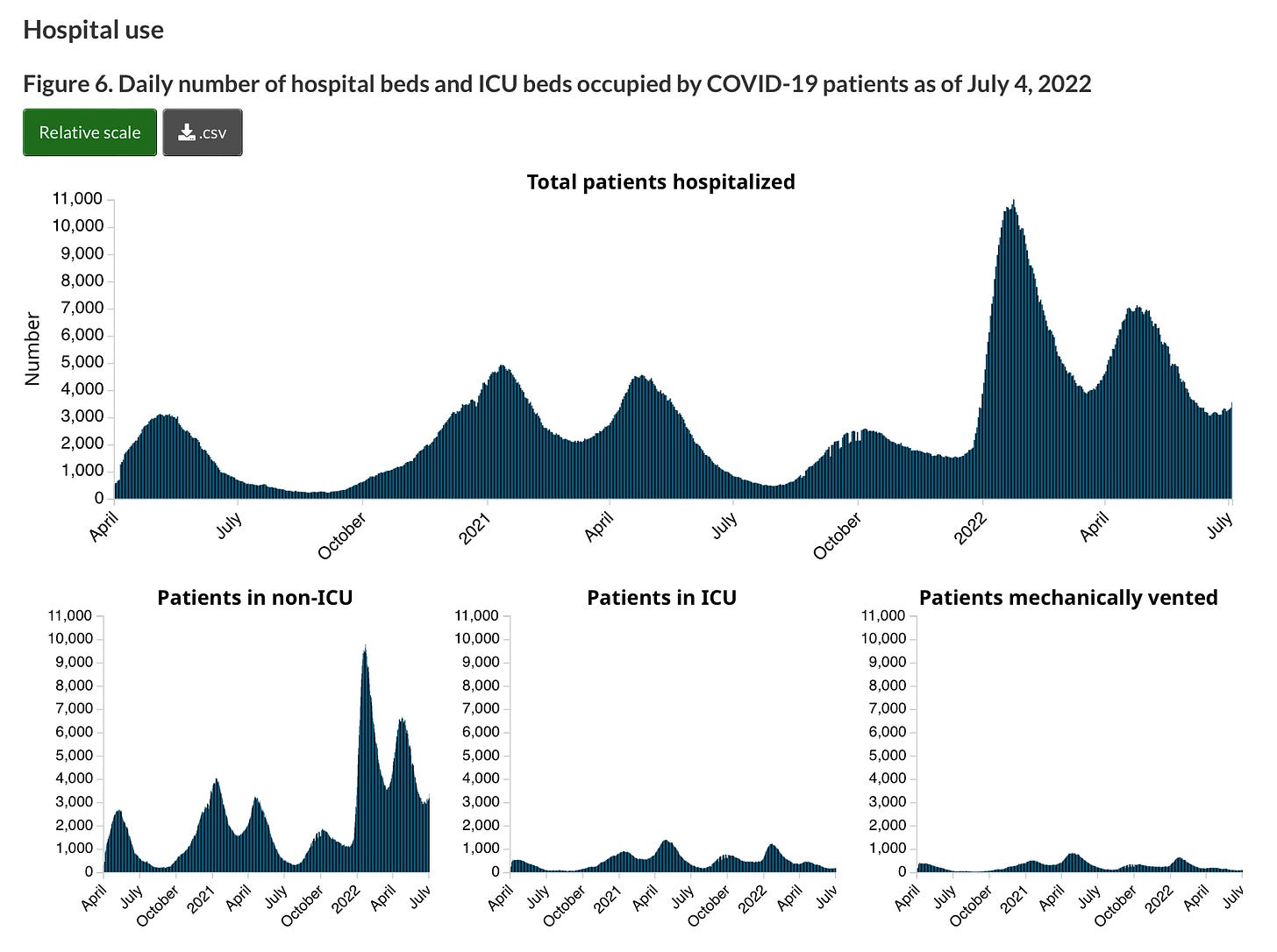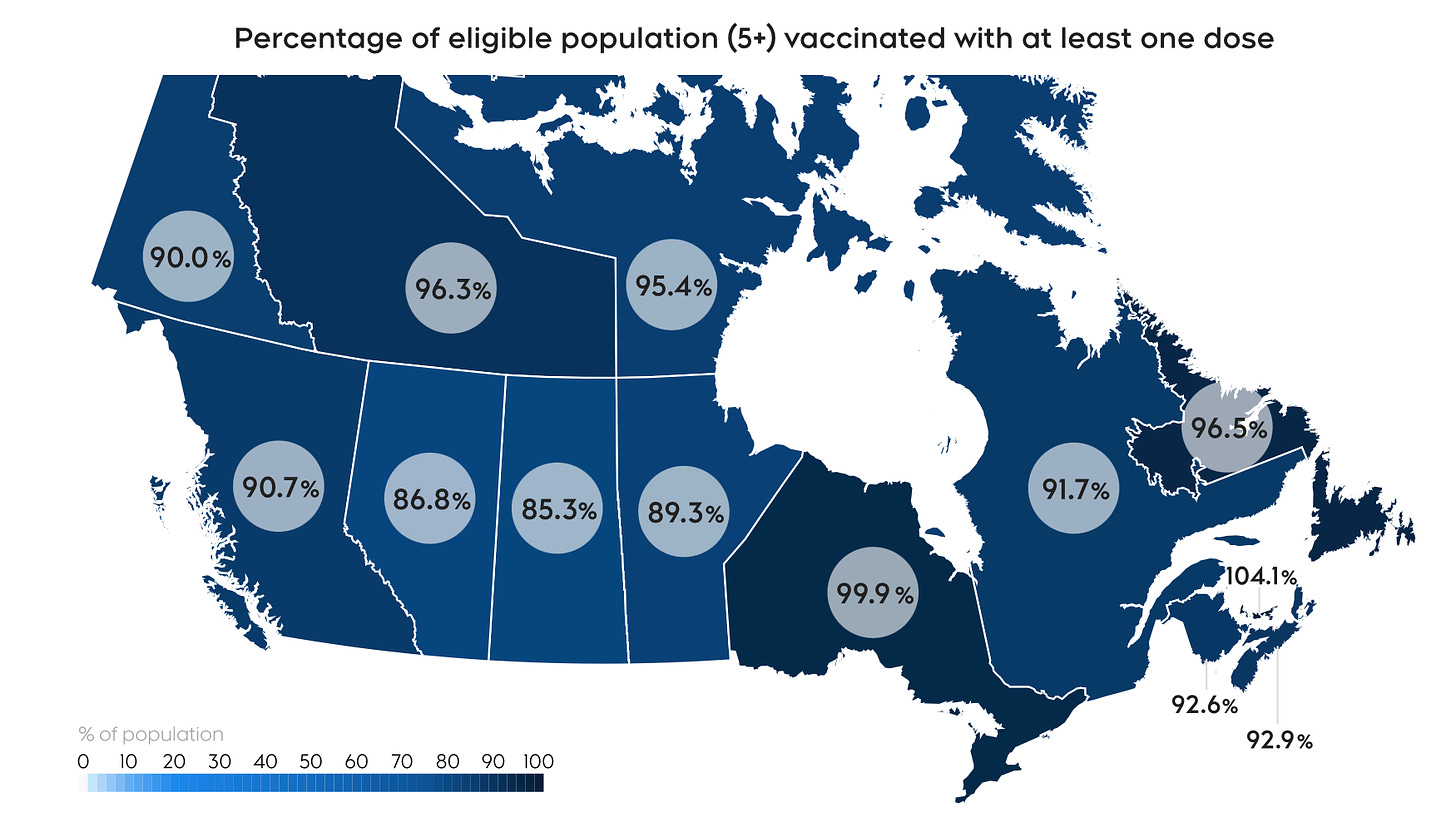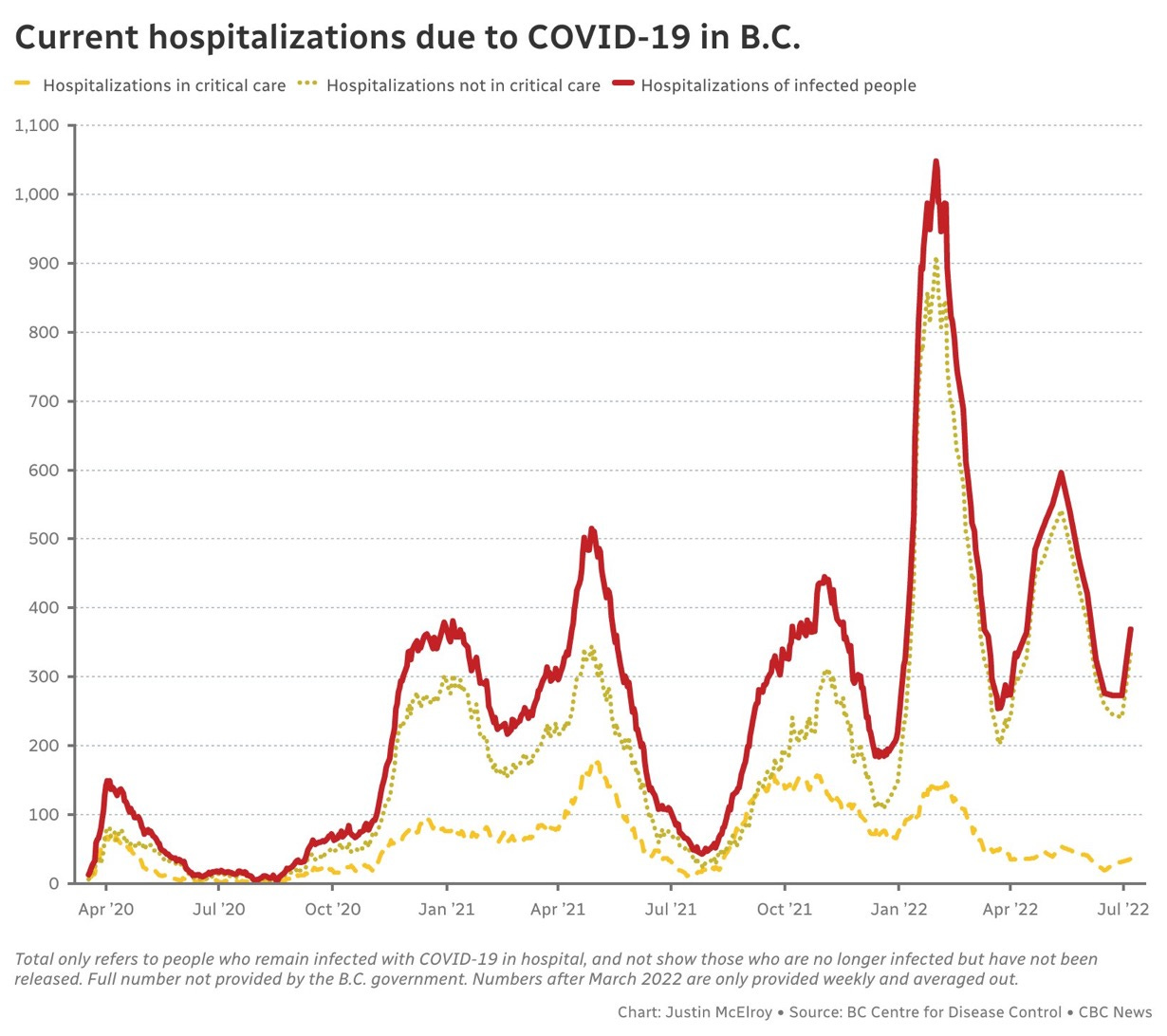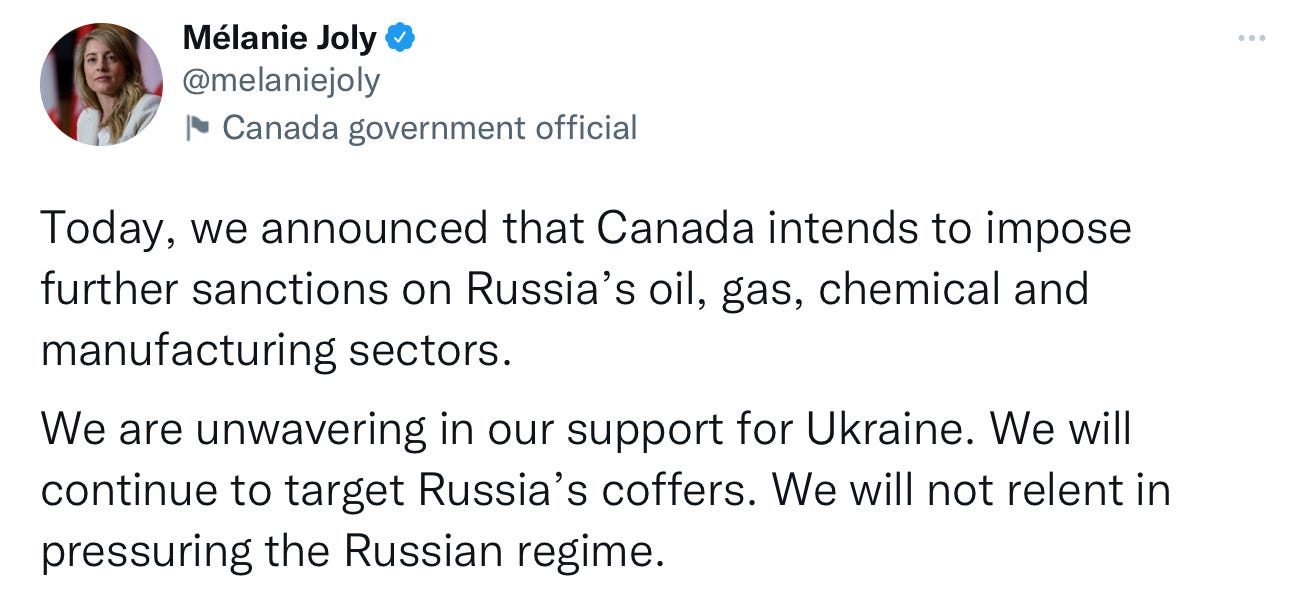🦠Pandemic🦠
WHO/ 🦠🌎
The World Health Organization’s COVID Technical Lead is again warning that we are playing with fire by letting the coronavirus “circulate at such intense levels.”
Maria Van Kerkhove notes a sobering statistic: that global pandemic deaths are at a similar level now to what they were in March 2020 when COVID was unleashed on the world. She says while virus death rates are well under peaks set during subsequent waves, lives are being lost needlessly now because “life-saving interventions” are not being used effectively.
“There are far too many dying unnecessarily when we have the tools to prevent them. Be vigilant, wear a mask, distance, get vaccinated, open windows, wash hands, test, isolate if infected, quarantine if in contact, be informed. Live your life but be safe. Your life is precious! The pandemic is not over and we have to live with this virus responsibly. We can do this. We must.”
Kerkhove says the BA.5 variant is sweeping across the globe and has now been detected in 83 countries with the strain’s prevalence rising from 37% to 52% in just one week.
🇪🇺🦠
The BA.5 wave continues to grow in Europe according to the latest weekly assessment from the Europe Centre for Disease Prevention and Control. Last week infection cases among vulnerable seniors have jumped by 32% week over week across 22 of 24 EU countries reporting data. Of concern, the ECDC notes increasing numbers of severe infection cases, especially among vulnerable seniors, are now increasing along with virus numbers.
COVID cases in Europe have now reached 62.8% of the highest peak seen in the winter Omicron infection wave. This is a fifth straight week of increasing coronavirus numbers.
Of the 33 countries reporting hospital and intensive care admissions numbers last week, 18 reported rising numbers in one or both categories.
A glimmer of good news looking at pandemic deaths where COVID death rates fell week to week, dropping from 7.0 deaths per million population to 5.9. Looking at the data at the country level, seven EU countries registered rising fatality numbers.
On the vaccination front, 72.7% of the total European population has two vaccine doses and 52.7% have had a booster dose.
The ECDC says data from the 15 countries with what it deems to be adequate numbers of COVID testing and sequencing shows that the BA.4/BA.5 variants now account for 72.1% of all sequences positive test results. 24% came back as BA.2 as the once dominant variant continues to fade. 9.2% of cases were BA.2 with the L452X mutation.
Over the next two weeks, the ECDC forecast paints a grim picture as it anticipates infection numbers, hospitalizations, and COVID deaths will all increase in the European Union and broader European Economic Area.
“It should be noted that forecasts of cases are considered to be increasingly unreliable due to changes in testing criteria and reporting procedures. All current forecasts, in particular case forecasts, should be treated with caution.”
-
COVID testing numbers remain much too low across most of Europe according to the European Centre for Disease Prevention and Control. Its latest map of testing levels continues to show a large swath of Europe is ‘greyed out’ due to testing levels so low there is “insufficient data” to determine an accurate pandemic picture.
Of note, while some colour returned to Denmark in last week’s map, testing levels have dipped again and it has returned to ‘grey.’
🇩🇰
The Statens Serum Institute no longer updates COVID statistics on weekends. It will table three days worth of pandemic data later today.
-
COVID hospitalizations over the last seven days in Denmark continues the trend of seeing the risk of severe infections requiring hospital care being highest among people 40 years old and older but especially among seniors over the age of 65.
-
The Danish Medicines Agency is waiting for the approval process for updated versions of the Pfizer/BioNTech and Moderna vaccines to run in its course. The newly formulated vaccines, called bivalent vaccines, are designed to counter two variations of the coronavirus, one of which is the Omicron variant. The agency notes that it is up to the European Medicines Agency to determine the updated formulas are safe, effective, and can be used in the EU. That process has been underway since mid-June. So far, clinical trials suggest the bivalent vaccine formula provides a broader response when used as a booster dose.
As part of the ‘variant updated’ approval process, vaccine manufacturers must document that the variant-updated vaccines are at least as good or better than the original vaccines to stimulate the formation of protective antibodies. In addition, they must document that they can produce the variant-updated vaccines in the same high quality as the vaccines already on the market.
At the same time, the Danish agency is also reassuring people that the original vaccines are still very effective at protecting against severe infection, hospitalization, and death. This has been backed up by a review by the ICMRA (International Association of Drug Regulators) and the WHO.
Lægemiddelstyrelsen compares the updating of the COVID vaccines to how influenza vaccines are updated every year to what is supposed to be the dominant strain to come. Both are highly contagious viral diseases and both mutate to produce new strains. Once the EMA recommends approval of the new bivalent vaccines, they can then be distributed for use across Europe. Denmark, like most EU countries, is hoping the bivalent vaccines will be approved for use in Europe in time for fall vaccination campaigns.
🇸🇪
The Swedish Public Health Agency updates its COVID numbers once a week every Thursday.
-
The BA.5 variant wave is complicating things at hospitals in Sweden’s capital region. In a meeting of Chief Physicians in Region Stockholm, it was noted that the week began with a “particularly high load” of patients in hospital emergency rooms. By the end of the week, occupancy remained high but the overall situation is stable.
“The increase in the number of COVID patients contributed to the high occupancy rate.”
This comes as overall hospital capacity is being reduced in order to allow staff to take summer holidays, further complicating the picture.
Chief Physician Johan Bratt recommends people who don’t need urgent or emergency care call the health line first before going to a hospital.
“The pandemic is not over and a high degree of infection remains both in society and in healthcare. It is worrying for all those who suffer from serious illness and their relatives. It is also increasing the demands for more staffed care places in the county. Vaccinations still provide the best protection against severe infection.”
Healthcare workers in Stockholm hospitals facing increasing numbers of COVID patients are now prioritizing care for those in emergency need or having a healthcare issue that cannot wait. Waiting times in Stockholm ERs are also increasing,
It is unclear if this is pandemic related or not, but the region says it is usually in the summer when most children are born but this summer in Stockholm, hospital maternity wards are seeing fewer births than years previous. Overall births are down in the region by 7% compared to 2021.
🇳🇴
The Norwegian Institute of Public Health is moving from a weekly to a bi-weekly pandemic assessment. It is also reducing the amount of information in its COVID situation summary.
In its latest pandemic snapshot, the NIPH estimates that the BA.5 infection wave may be nearing its peak. It expects the peak to be reached this month with the wave ebbing immediately afterward.
COVID admissions in Norway have continued to rise as they have for several weeks now, but ICU numbers have been stable. There were 335 hospitalizations due to a coronavirus infection in week 26 compared to 304 the week before. The median age of COVID patients over the last weeks has been 76 years old. There were nine ICU admissions in week 26 after 13 the week prior. The agency says that so far people hospitalized with a severe BA.5 infections are remaining in hospital for roughly the same length of time that BA.2 patients did.
“The situation is still unpredictable, and new variants can change the situation. The health institutions must be prepared for more hospitalizations, for outbreaks and for greater sickness absence.”
The NIPH says COVID deaths are creeping upward after 63 lives were lost to the virus in week 26, after 61 the week before. 57% of all pandemic deaths in that period took place primarily in a senior care home.
Respiratory symptoms in the population: Data from the population survey
COVID wastewater monitoring in Norway indicates that virus activity may be plateauing after weeks of increases.
For a 3rd straight week, the number of infection cases showing up at their family doctors or an emergency room has increased.
There were 39 outbreaks in hospitals and other healthcare facilities in week 26, with 22 the week before and 21 the week before that.
PCR COVID testing rates decreased in Norway last week.
As is to be expected, the BA.5 variant remains dominant in Norway, accounting for around 80% of all sequenced positive test results in week 24.
The NIPH pandemic assessment ends with the following warning.
“Other variants that to an even greater extent than BA.5 avoid existing immunity are in circulation in the world and it is uncertain how long the dominance with BA.5 in Norway will last.”
-
Clear, timely communication. That is one of the biggest takeaways from focus groups conducted between the Norwegian Institute of Public Health and nine Norwegian municipalities. The goal was to put Norway’s pandemic response under the microscope and see what has worked in the last year and what hasn’t.
Director Frode Forland says relaying information in a clear logical way was a key take away.
“Municipalities have told us that it is important to have good information when there is a change in national [COVID] measures. The municipalities would appreciate being informed about changes in advance of press conferences, as they need some time to prepare and introduce comprehensive measures, such as tests for quarantine for school children. Good information can prevent unrest.”
The results also indicated that in some cases, targeted local restrictions were better suited than national measures. On the other hand, implementing local measures is a big job requiring lots of work and experienced staff to carry it out.
“It can be more demanding to phase out measures than to introduce them. Discontinuation of individual measures can also lead to pressure on other services such as local testing and contact tracing.”
The NIPH said that the municipalities also emphasized that they saw first-hand the negative consequences socially, mentally, and financially, that restrictions had on people. To that end, they stressed that any severe restrictions shouldn’t last longer than absolutely necessary to mitigate negative impacts.
Another key take away was that there must be a “very compelling” reason for closing schools with any benefits of locking a school down weighed carefully against the negative consequences on the children.
The focus group also concluded that Norway could use a digital national infection tracking tool. This is something that could be advantageous, not just for COVID, but also for other future outbreaks.
🇫🇮
The Finnish Institute for Health updates its COVID numbers once a week, every Thursday.
-
The number of new COVID infections remains high in Finland, and due to a lack of testing, is likely much higher, but deaths have decreased somewhat since peaking in the spring. Wastewater surveillance also indicated that virus activity across Finland remains high.
Finns will have to learn to live with coronavirus as a “permanent part of life” according to the Chief Physician of the Helsinki Uusimaa Hospital District.
Asko Järvinen was speaking to Yle TV1:
“We can't get rid of it. Yes, coronavirus is here to stay. We cannot eliminate it with vaccines or restrictions.”
Järvinen added he doesn’t support administering a 2nd booster dose to the general public. He says since Finland administered vaccines over a longer period of time than other countries, the population has higher levels of protection.
“Our three vaccines provide protection that is equivalent to four vaccines elsewhere.”
Currently, the Finnish Institute for Health offers a fourth dose to elderly seniors 80 years old and older and seniors 70 years old and older who belong to high-risk groups. This will change in the fall when the eligibility for a fourth dose will be expanded.
🇩🇪
Germany’s Health Minister is warning that the threat of long-COVID is “hugely underestimated” and that people should not take exposing themselves to infection lightly.
“We don't even begin to have the therapy places for it. We don't have the capacity to take care of the sheer number of cases."
Minister Karl Lauterbach says the long-term impacts of long-COVID cases are a threat to people’s health, to the healthcare system, and even to society as a whole.
Lauterbach spoke to Zeit Online over the weekend:
“We don't even begin to have the capacity to take care of the many cases. There are not enough specialized doctors, not enough treatment places, we don't have any medication yet. This will also be relevant for the labour market, because unfortunately many will not return to their old productivity levels.”
He says every infection brings with it the risk of being afflicted with long-COVID. Lauterbach is urging people to take every precaution and especially to get vaccinated.
“Because hopefully this will not only protect against a severe infection but also against long-COVID.”
According to statistics from Germany’s Techniker Krankenkasse published last week, almost 1% of employers who tested positive with a PCR test in 2020 were still on sick leave in 2021 due to a long-COVID diagnosis. On average, workers suffering from long-COVID were out sick for 105 days.
-
With an expected fall and winter COVID infection wave, Germany’s Health Minister says preparations are already well underway to mitigate impacts and hopefully minimize infection numbers. The plan includes a three phase vaccination strategy. First closing existing vaccination gaps, phase two will be a new fall inoculation campaign, and the third phase could involve newly formulated vaccines.
German Health Minister Karl Lauterback says these are updated mRNA vaccine doses that are designed specifically for the Omicron variant. He says more news on that front should come in the next three weeks.
The fall COVID strategy also banks on increased testing and making access to testing easier. Along with testing, pandemic knowledge is also key, so every hospital in Germany will be required to report virus data this fall. Wastewater surveillance will also play a major role in early detection. Another strategy plank is the use of anti-vital medications, which could reduce mortality due to an infection among at-risk patients by 70%. Last but not least, the plan increases protections for healthcare workers via vaccination, rapid use of anti-viral medication in the event of an infection, and personal protective equipment requirements.
The strategy also calls for “school protection concepts” to try to minimize class cancellations and school shutdowns. What those concepts are, it doesn’t say.
🦠New Variant Watch🦠
Keeping an eye on the new variant BA.2.75, which has epidemiologists concerned. Last week the WHO said it is also monitoring this new evolution of the BA.2 strain. It continues to gain stream in India and has now been confirmed in both Indonesia and Nepal. The variant continues to grow in India, up 22% nationally, and in populace Maharashtra State (Mumbai), the growth rate is up 43%.
Looking at the growth advantage against all other variants in India, and BA.2.75 seems to have a major edge, with a daily growth advantage of 14.3%.
Chart from Australian Data Visualization Specialist Mike Honey.
🇨🇦
As the BA.5 wave crashes across Canada, COVID hospitalization numbers are rising again. In the week ending July 4, the Public Health Agency of Canada latest weekly updates says the total number of hospital beds in use by coronavirus patients rose from 3,256 to 3,552. Looking at just general admissions, the number of hospitalized infection cases rose by 282. While intensive care admissions increased by 15. The number of people on a ventilator crept up by 5.
Canada reported 21,317 coronavirus infections last week along with another 127 pandemic deaths.
The seven-day positivity percentage was 14.3%.
-
The Canadian vaccination effort has so far administered 33,730,055 1st vaccine doses (88.22% of the total population) while 31,432,400 people (82.21%) have a 2nd dose and of those 20,642,683 people are fully vaccinated with three doses.
-
In B.C, COVID hospitalizations have jumped by 35% week to week with 369 admissions.
Chart from CBC Vancouver’s Justin McElroy.
Wastewater surveillance has also increased sharply in Metro Vancouver with virus activity doubling in two of the region’s five facilities.
-
The province also announced it would expand eligibility for a 2nd vaccine booster dose in the fall. Currently, only British Columbians 70 years old and older, those who are immunocompromised, and First Nations 55 years old and older, can get a 4th dose. In the fall, everyone 12 years old and older will be able to get another booster.
-
Across the other provinces, a BA.5 variant wave has either already arrived or is arriving. Alberta wastewater surveillance is showing rising virus activity while health officials in Ontario and Quebec confirmed last week another infection wave has begun.
🇺🇦/ 🇷🇺 War
🇩🇪 🇳🇴/ 🇺🇦
According to a report from Der Spiegel, Germany has secured a long-term supply of ammunition for Ukrainian Armed Forces. Germany’s efforts to get ammunition, especially for certain anti-aircraft systems, had been blocked by Switzerland. But according to the report, Germany has reached an agreement with Norway to supply the ammunition, thereby circumventing Switzerland’s ammunition supply restrictions. This also clears the way for Gepard anti-aircraft systems to be delivered to Ukraine.
🇨🇦/ 🇷🇺
Canada is adding more sanctions to the pile Russia is already facing. The Canadian Foreign Affairs Ministry announced over the weekend that it will expand sanctions already in place that are aimed at Russia’s oil, gas, and chemicals industries to include industrial manufacturing. The sanctions apply to the manufacturing of all metals, computers, electronics, electrical equipment, and machinery. It also covers land and pipeline transport. This cuts off Canadian services from contributing to the production of Russian goods in all three sectors. For any existing business with Russia in the impacted sectors, Canadian companies will have 60 days to wrap up contracts once the new sanctions come into force.
Foreign Affairs Minister Mélanie Joly says this will help deplete Russian President Vladimir Putin’s war chest and kneecap his ability to wage war in Ukraine.
“Canada is unwavering in its support of Ukraine’s sovereignty and territorial integrity. Putin’s unjustifiable war has affected millions in Ukraine and across the world. That is why we will continue to target the Russian regime’s coffers. Canada will not relent in pressuring the Russian regime.”
Since Russia illegally occupied Crimea in 2014, Canada has imposed sanctions on more 1,600 Russian individuals or entities. Since the invasion of Ukraine, sanctions have been targeted at another 1,150 Russians, Belarusians, and business entities in both countries.
🇨🇦/ 🇺🇦
The Ukrainian government isn’t very happy with Canada. The Ukrainian Foreign Affairs and Energy ministries are calling on Canada to not return a repaired turbine for the Russian Nord Stream 1 pipeline to Germany. Russia has blamed its restrictions on gas supplies through the pipeline on delayed repairs to the turbine in Canada. Ukraine says this is Russia, using its energy supplies as a “hybrid warfare” tool against Europe. It stresses that the pipeline has several turbines, including some on standby, and any restrictions of gas supplies through the pipeline is “blackmail that has no technical justification.”
That turbine was sent to Montreal for repairs. It has been stuck there due to Canadian sanctions against Russia's oil and gas industry. Germany, already facing an energy crisis, has proposed a detour for the turbine through Germany. Over the weekend Canadian Natural Resources Minister Jonathan Wilkinson said Canada will hand over the turbine even as it expands sanctions against Russia.




